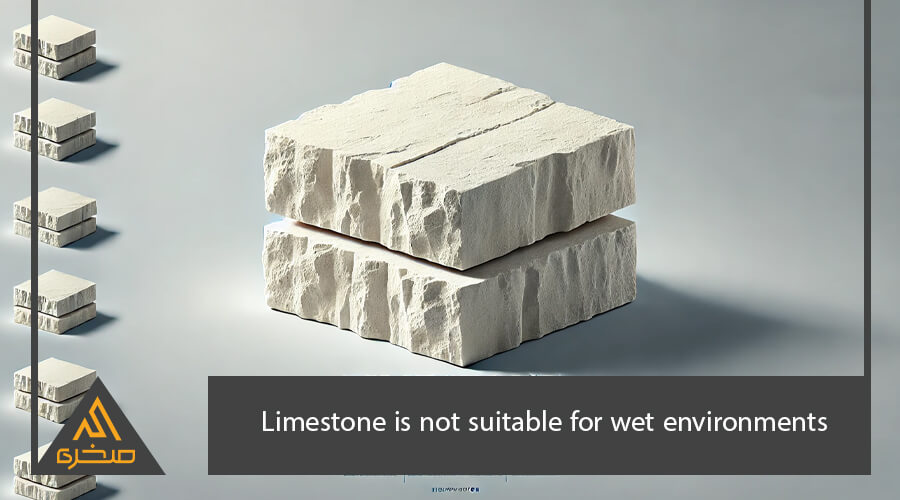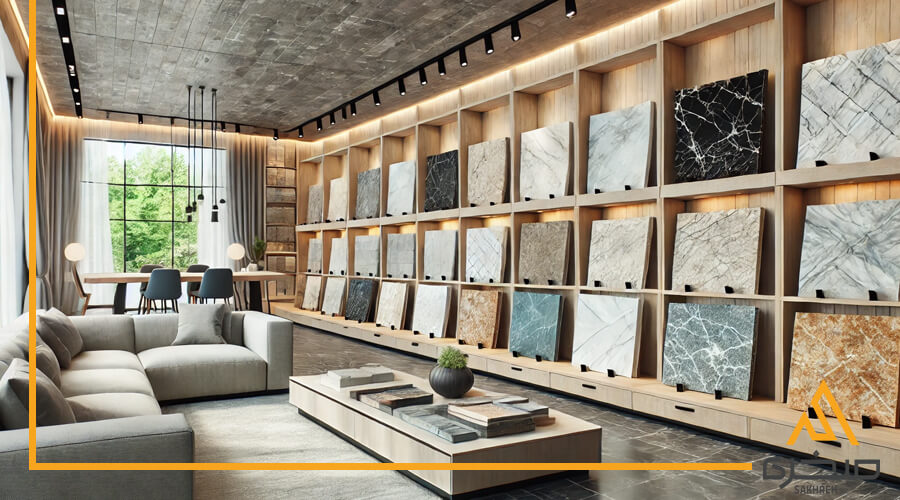- No comments

A comprehensive guide to all types of building stones: review of features, advantages and disadvantages
Building stones are among the most commonly used materials in construction, valued for their beauty, durability, and unique properties, making them ideal for various architectural projects. Each type of stone has specific advantages and disadvantages based on its characteristics and properties, which must be considered. In this article, we provide a comprehensive review of the features and applications of different building stones, including granite, limestone, marble, scratch stone, travertine, antique stone, gabbro, and quartz, along with tables comparing the pros and cons of each type. If you are looking to purchase high-quality and diverse building stones, Sakhreh Stone is one of the best options for selecting and buying various types of building stones.
1. Granite
Granite is one of the most popular building stones worldwide, known for its hardness and high durability. This igneous stone forms through the slow cooling of magma beneath the Earth’s surface.
Features
- High resistance to pressure and scratches: Ideal for high-traffic areas or outdoor environments.
- Water resistance: Due to its dense structure, granite absorbs minimal water, making it suitable for moist environments.
- Heat and chemical resistance: It withstands direct heat and exposure to strong chemicals.
- Natural beauty and color variety: The fine crystal patterns give granite a unique aesthetic appeal.
Applications
- Interior flooring and wall cladding: Durable and aesthetically pleasing for luxury designs.
- Kitchen countertops: Scratch and stain-resistant, making it perfect for kitchen surfaces.
- Outdoor paving: Suitable for weather-resistant pathways and high-pressure areas.
- Columns and staircases: Often used in modern and upscale projects.
| Advantages | Disadvantages |
|---|---|
| High scratch and impact resistance | Heavyweight, complicating installation |
| Long lifespan | High extraction and installation costs |
| Moisture and chemical resistance | Requires specialized cutting and installation |
| Variety in colors and patterns | Limited customization options |

2. Limestone
Limestone, also known as calcium carbonate, is a sedimentary stone widely used in construction due to its softer texture and neutral tones.
Features
- Soft and easy to process: Ideal for creating intricate designs.
- Subtle, natural colors: Ranging from white and cream to gray, adding calmness to interiors.
- High porosity: Requires waterproof coatings in humid environments.
- Lightweight compared to other stones: Easier to install than granite or marble.
Applications
- Building facades: Popular for modern and natural appearances.
- Interior design: Flooring and wall cladding in low-moisture areas.
- Sculptures and decor: High processability makes it suitable for artistic purposes.
| Advantages | Disadvantages |
|---|---|
| Lightweight and easy installation | High water absorption and vulnerability to moisture |
| Simple processing for custom designs | Less durable than harder stones |
| Cost-effective | Requires regular maintenance and coatings |
| Elegant natural colors | Sensitive to weather changes |
3. Marble
Marble is considered a luxurious stone, admired for its unmatched beauty and unique texture. It is formed through the metamorphosis of limestone under heat and pressure.
Features
- Natural sheen: Its polished surface gives a sophisticated look to interiors.
- Pressure resistance: Suitable for flooring and weight-bearing surfaces.
- Wide color variety: Available in shades like white, green, black, and pink.
- Susceptibility to acids and scratches: Can be damaged by acidic substances or sharp objects.
Applications
- Interior flooring and wall cladding: Especially in luxury spaces like hotels and halls.
- Countertops: Ideal for premium kitchen designs.
- Artwork and sculptures: Highly processable and polishable for artistic works.
| Advantages | Disadvantages |
|---|---|
| Luxurious appearance with natural gloss | High sensitivity to acids |
| Unique designs for creative use | Expensive |
| Extensive color options | Requires continuous care |
| Moderate pressure resistance | Prone to scratching |

4. Scratch Stone
Scratch stone is a modern and distinctive building material often used for creating unique and attractive designs.
Features
- Modern look with textured grooves: Ideal for contemporary and creative designs.
- Scratch resistance: Suitable for exterior cladding.
- Weather resistance: Perfect for harsh environmental conditions.
Applications
- Modern facades: Used in contemporary projects.
- Interior decorative walls: Adds character to unique designs.
- Column cladding: Provides a standout appearance.
| Advantages | Disadvantages |
|---|---|
| Unique and distinctive appearance | High design and installation costs |
| Resistant to weather conditions | Limited color variety |
| Durable | Challenging to process and cut |
| Suitable for exterior use | Expensive to repair |
5. Travertine
Travertine is a popular sedimentary stone, appreciated for its variety of colors and natural patterns.
Features
- Lightweight with high adhesion: Easily bonds to mortar and is lighter than granite.
- Warm, natural colors: Available in cream, gold, and brown hues.
- Porosity: Provides a natural appearance but requires maintenance.
- Sound and heat insulation: Ideal for residential buildings.
Applications
- Building facades: Lightweight and adhesive.
- Garden pathways: Adds natural beauty to landscapes.
- Pools and moist areas: Durable in wet environments.
| Advantages | Disadvantages |
|---|---|
| Lightweight and easy installation | Requires regular maintenance |
| Natural and beautiful appearance | High water absorption |
| Sound and heat insulation | Sensitive to chemicals |
| Affordable | Less durable than granite or marble |

6. Antique Stone
Antique stone, a composite of natural and artificial elements, is valued for its decorative and aesthetic appeal.
Features
- Decorative and elegant: Used in both interior and exterior designs.
- Durable: Resistant to wear and environmental changes.
- Versatile in designs and colors: Can blend with various construction materials.
Applications
- Interior decorative walls: Suitable for both modern and classical spaces.
- Building facades: Adds uniqueness to exterior designs.
- Fireplaces and columns: Enhances decorative elements.
| Advantages | Disadvantages |
|---|---|
| Attractive appearance | High design costs |
| Durable | Difficult to install and maintain |
| High versatility | Limited structural applications |
| Relatively lightweight | Susceptible to harsh weather |
7. Gabbro
Gabbro is an igneous stone known for its durability and strength, making it ideal for heavy-duty applications.
Features
- Dark colors and dense texture: Usually in black, gray, or dark green tones.
- High pressure and abrasion resistance: Suitable for high-traffic areas.
- Water resistance: Absorbs minimal water due to its dense structure.
- Weather durability: Ideal for extreme temperature variations.
Applications
- Road and pathway paving: High abrasion resistance for heavy use.
- Bridges and tunnels: Used in large construction projects.
- Modern facades: Provides a sleek and minimalist appearance.
- Industrial flooring: Ideal for factory settings due to its strength.
| Advantages | Disadvantages |
|---|---|
| High resistance to pressure | Heavy, complicating transport and installation |
| Long-lasting durability | Limited color variety |
| Moisture-resistant | Expensive extraction and processing |
| Suitable for high-traffic areas | Limited decorative use |

8. Quartz
Quartz is an engineered stone made by combining natural materials with resin. It is known for its aesthetic and functional qualities.
Features
- Polished and shiny surface: Creates a modern and sleek look.
- Non-porous structure: Stain and water-resistant.
- High scratch and impact resistance: Among the most durable artificial stones.
- Wide range of colors and designs: Suitable for various preferences and spaces.
- Low maintenance: Unlike natural stones like marble, quartz requires minimal upkeep.
Applications
- Kitchen countertops: Resistant to stains and acids.
- Interior wall cladding: Especially for modern spaces.
- Tables and work surfaces: Ideal for offices and luxury environments.
- Bathrooms: Resistant to moisture, making it perfect for wet areas.
| Advantages | Disadvantages |
|---|---|
| Water and stain resistance | High production costs |
| Variety in colors and designs | Artificial appearance may not suit some projects |
| Scratch and impact resistance | Sensitive to high heat |
| Low maintenance | Relatively heavy |
Conclusion
In this article from the Sakhreh blog, we explored how building stones, due to their high diversity, durability, and beauty, are among the primary choices for architectural and construction projects. Each stone, such as durable granite, marble, and travertine, has unique characteristics that make it suitable for specific applications. An informed selection of stone can have a significant impact on the longevity and appeal of a project.
New Articles


